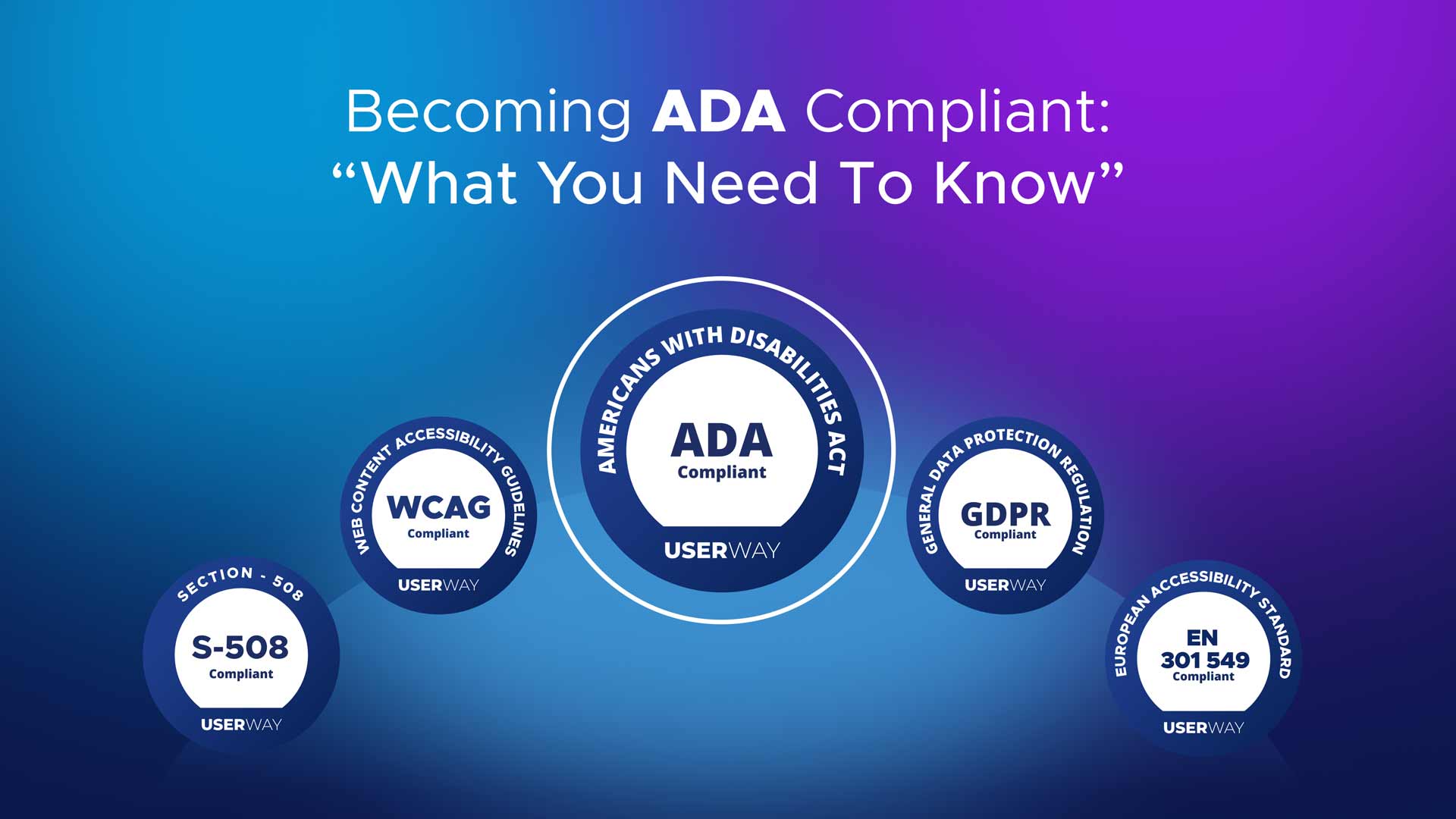Being ADA Compliant: What You Need to Know

Are you confident that your website is ADA compliant, or do you find yourself struggling to understand what ‘ADA compliant’ means with its legal implications and requirements?
If the term ‘ADA compliant’ leaves you with questions, you’re not alone. Many website owners and developers grapple with the complexities of the Americans with Disabilities Act (ADA), navigating its requirements for online accessibility and facing potential consequences if they don’t comply.
To design an inclusive digital platform, it’s important to be familiar with the ADA compliant definition, which emphasizes equal access and usability. In this article, we’ll explain the meaning of ‘ADA compliant‘ in relation to digital assets, explaining the distinct difference between ADA and Section 508, the importance of the WCAG in web accessibility and the expanding legal interpretation of online accessibility requirements.
Meeting ADA compliance in websites and apps
The ADA, a U.S. federal law enacted in 1990 and subsequently amended, is designed to prevent discrimination against individuals with disabilities in all facets of public life.
While the ADA itself doesn’t explicitly outline requirements for digital content, various court rulings have extended its scope to include websites and mobile apps. ADA compliance means that websites or apps should be fully usable by people who have various types of disabilities.
Under the Americans with Disabilities Act (ADA), a disability is defined as a physical or mental impairment that substantially limits one or more major life activities. This broad definition encompasses a range of conditions, including but not limited to:
- Visual Impairments: The content should be easily navigable and readable for those using screen readers or Braille displays.
- Hearing Impairments: Videos should include captions, and audio content should have accompanying transcripts.
- Motor Disabilities: The platform should be navigable using various assistive technologies like adaptive keyboards, or via simple keyboard commands for those who cannot use a mouse.
- Cognitive Disabilities: Content should be straightforward and easy to understand, with options to disable features like rapidly flashing or blinking elements that could induce seizures in susceptible individuals.
By considering the diverse needs outlined above, you not only make your website or app accessible, but also demonstrate a commitment to inclusivity. Let’s take a close look at the ADA and see how it aligns with other accessibility guidelines.
WCAG: The Gold Standard of ADA Compliance
The Web Content Accessibility Guidelines (WCAG) plays a key role in ADA compliance. Developed by the World Wide Web Consortium (W3C), a non-governmental international standards organization, these guidelines provide a comprehensive set of recommendations for making web content more accessible to people with disabilities.
While the ADA doesn’t specifically mention WCAG, many legal experts and practitioners consider adhering to these guidelines as a reliable way to meet the ADA’s requirements for non-discrimination and equal access. This is because the WCAG offers clear, actionable standards for various elements of web design and functionality, ensuring that websites and online platforms are usable by individuals with a range of disabilities. Whether it’s because of an enforcement action, court ruling or a settlement, WCAG are the go-to rules for the U.S. Department of Justice, judges and lawyers to make sure websites are accessible to everyone.
Updated periodically, WCAG aims to stay relevant as technology advances, and its tiered system (Levels A (minimum), AA (mid-range), and AAA (highest)) offers flexibility in implementing varying degrees of accessibility. By following the WCAG’s criteria, businesses and website developers can minimize the risk of ADA-related lawsuits and create more inclusive online experiences for all users.
The Untapped Potential of Digital Accessibility
By creating an ADA-compliant website or app, you are opening doors to a quarter of the adult population who might otherwise be unable to access your services or products. One of the most compelling advantages of digital accessibility is its potential to reach a broader audience. In the United States alone, 1 in 4 adults have some type of disability. That’s a significant portion of the population that could be excluded from interacting with your digital content if it’s not accessible.
Similarly, the European market also presents a considerable opportunity for expanded reach through digital accessibility. Approximately 87 million people in the European Union live with some form of disability. By ignoring accessibility, you risk alienating millions of potential European users who could contribute to your organization’s success.
It’s startling to note that only 3% of the web is accessible to people with disabilities, according to current estimates. This disparity highlights the urgent need for more websites and apps to become ADA compliant and aligned with WCAG guidelines. Failing to do so not only misses out on a massive audience but also risks potential legal complications.
The Legal Risks of Inaccessible Digital Assets
As we’ve mentioned, failing to make your digital assets ADA compliant can expose you to legal risks. Inaccessible website owners can be successfully sued in several plaintiff-friendly jurisdictions. What’s more, your business doesn’t have to be incorporated or located in a state or federal district to be hauled into a court in a different jurisdiction.
Federal and state courts often look at whether the company has “purposefully availed” itself of the privilege of conducting business in the jurisdiction in question. For example, if an e-commerce company targets customers in a particular location, even if they don’t have a physical presence there, they could potentially be hauled into court there.
Also, state long-arm statutes allow a court to exercise jurisdiction over out-of-state defendants if they have systemic and continuous contacts with the state or caused harm there.
Furthermore, there is no finality, which means if you’re sued once, you can be sued by another plaintiff in the same or another jurisdiction, if you don’t take the necessary steps to make your website accessible.
Finally, if your organization is sued and settles or loses the case, it will be costly. You will need to pay either a settlement amount or damages, as well as legal fees – plaintiff’s and your own.
The Rise in ADA Lawsuits
There has been a noticeable surge in ADA lawsuits in federal courts. High-profile companies like Domino’s Pizza, Edx, American Express, and Carnival Cruise Ships have faced legal action and ended up paying significant settlements. Other corporations, including McDonald’s and Kmart, have opted to settle cases out of court to avoid litigation.
However, in addition to large corporations, small and medium businesses are hit with demand letters and lawsuits each year.
This all serves as a wake-up call for businesses to audit their websites and digital platforms for compliance with accessibility standards.
Now we have shared insights on ADA compliance, accessibility and WCAG standards, there’s another vital piece of legislation in the web accessibility landscape—Section 508. Let’s find out more.
UserWay: the fast track to ADA compliance and inclusion
In today’s digital age, web accessibility is a fundamental cornerstone of any successful website. When building a website, understanding the implications of the ADA is crucial to ensure that all content is compliant and usable by everyone. UserWay’s AI-Powered Accessibility Solution helps organizations in their journey to reach ADA compliance.
By bridging the gap between complex regulatory requirements and the ever-evolving dynamics of web design, UserWay’s suite of accessibility solutions can help foster online environments that are welcoming to all users. In just a few clicks, you can transform your website into a fully accessible, ‘ADA compliant’ platform, opening the digital doors wide to a more diverse audience. Learn more by requesting a free demo today.
FAQS
What is ADA compliance for websites?
ADA compliance ensures websites are equally accessible to users with disabilities, based on the Americans with Disabilities Act (ADA). Although not explicitly mentioned in the ADA, online accessibility is viewed as a requirement for public and commercial entities, by the U.S. Department of Justice, courts, and legal practitioners.
How do I know if my website is ADA compliant?
Check if your website meets the Web Content Accessibility Guidelines (WCAG). Automated tools can help, but manual testing offers thorough insights.
What are the potential consequences of not making my website ADA compliant?
Non-compliance can lead to legal lawsuits, damage to brand reputation, and missed business opportunities due to inaccessibility.




Share